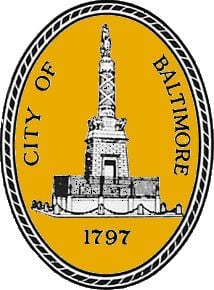Type Unicameral Last election November 8, 2016 | Seats 14 | |
 | ||
Council President Bernard "Jack" Young, DemocraticSince 2010 Committees ListBudget and AppropriationsEducation and YouthExecutive AppointmentsHealthHousing and Community DevelopmentJudiciary and Legislative InvestigationsLaborLand Use and TransportationPublic SafetyRecreation and ParksTaxation, Finance, and Economic DevelopmentUrban Affairs and Aging Voting system Electoral districts with four-year terms | ||
The Baltimore City Council is the legislative branch that governs the City of Baltimore and its nearly 700,000 citizens. It has 14 members elected by district and a president elected at-large; all serve four-year terms. The Council holds regular meetings on alternate Monday evenings on the fourth floor of the Baltimore City Hall. The Council has seven standing committees, all of which must have at least three members.
Contents
To qualify for a position on the Council, a person must be 18 years of age, a registered voter, a U.S. citizen, and a resident of Baltimore and the district. If a position on the Council is vacated, a new representative from the Council District is elected by a majority vote of the Council. The President receives an annual salary of $100,450 (as of 2009); other councilmembers get $57,000 (as of 2007). The current city council was sworn in on December 8, 2016, with 8 new members among those inaugurated.
History
In 1729, the Maryland General Assembly authorized the erection of Baltimoretown on the north side of the Patapsco and appointed a group of commissioners to govern it. In 1797, the General Assembly granted a charter that created the office of Mayor and City Council. The Council was divided into 2 branches, and membership required heavy property qualifications. During its early history the council was composed exclusively of white, non-Jewish males.
In 1826, the Maryland General Assembly passed the "Jew Bill", which allowed Jews to hold public office in the state. Two leaders in the fight for the law were Jacob I. Cohen Jr. (1789–1869) and Solomon Etting (1764–1847), who subsequently won election to the Council and became the first Jewish officeholders in the state.
In 1890, Harry Sythe Cummings was elected to the council, becoming the state's first black elected official. In the 40 years after 1890, six black Republicans won elections to the council.
In 1918, the General Assembly enacted all local laws affecting the city; since then the Mayor and City Council assumed those responsibilities. In the November election of 1922, the voters through petition replaced a two-branch council with a unicameral one and Baltimore abolished its old system of small wards, replacing them with much larger districts. In 1943, Ella Bailey became the first woman elected to the City Council.
In 2003, as a result of the ballot initiative, Question P, the Baltimore City Council went from six three-member districts to 14 single-member districts or from 18 members to 14 members. The council president continued to be elected at-large.
Records
The records of the City Council, dates ranging from 1797 to 1987, reside at the Baltimore City Archives in Record Group BRG16. The collection includes administrative files, volumes of proceedings, joint council session reports, correspondence, ordinances and resolutions, committee bills, hearing schedules, and other records.
